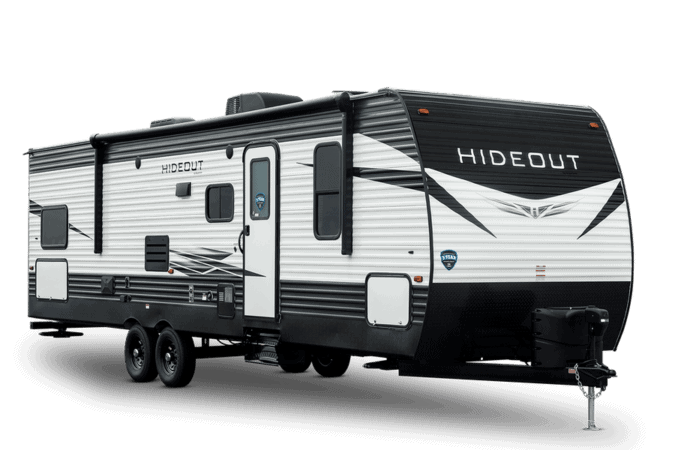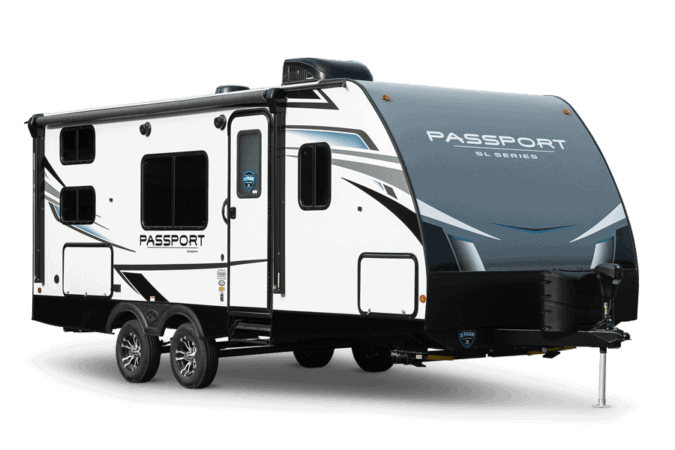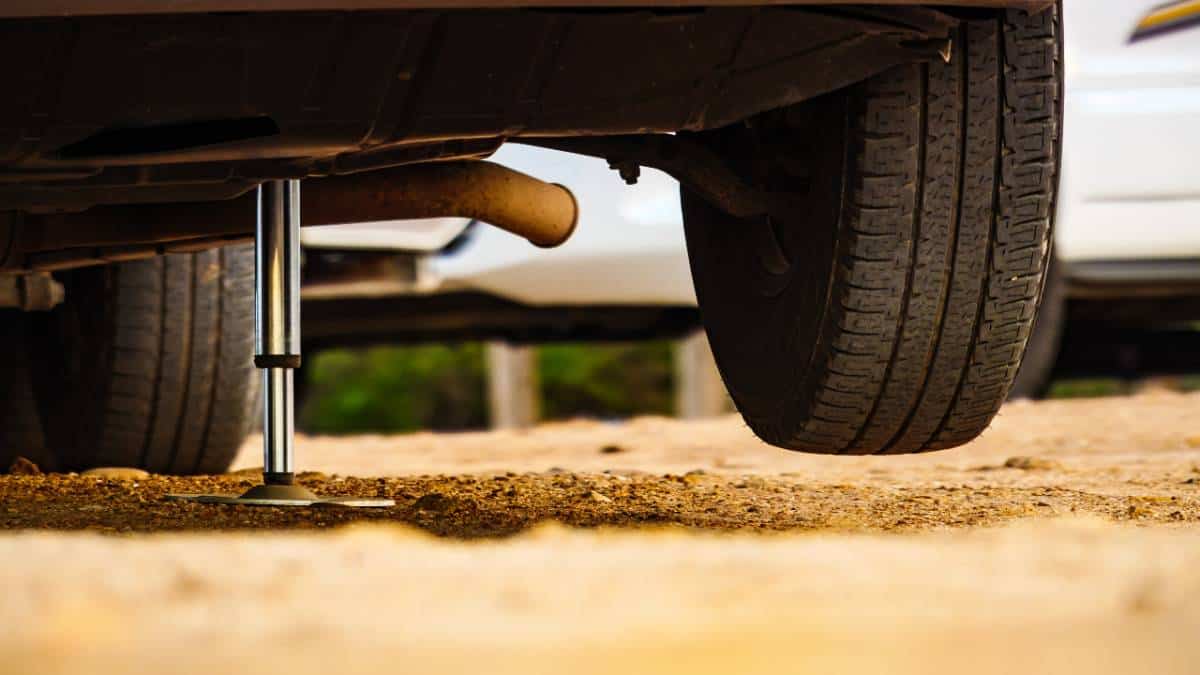For those of you who are hood poppers instead of button pushers at the car dealer, you understand the importance of knowing what’s under the hood. You want to know that this vehicle is safe, reliable, and will last a long time. You may have the same concern when you consider wood-framed versus aluminum-framed RVs. Which RV construction method is the best?
Our discussion will take you into the skeleton of RV construction to show you the benefits of conventional wood-framed RVs and the newer extruded aluminum-framed travel trailers. We’ll use real-world example RVs to show you the effects each frame goes through and the practical solutions. We’ll also sort through the misconceptions about Azdel and show you what it can and can’t do. Finally, you’ll learn about one series of travel trailers that offers you the best of both worlds.
Defining the Two RV Construction Materials
The RV industry uses the term “Sticks and Tin” when they talk about travel trailers with wooden frames and corrugated aluminum shells. Conversely, those travel trailers and fifth wheels with an aluminum skeleton and fiberglass paneled skin are monikered as “laminated” RVs.
To keep our discussion practical, we’ve chosen two travel trailer examples similar in the floorplan, length, slideouts, and other features. The only main differences are their RV construction materials. Instead of talking in the abstract, we’ll refer to these two coaches throughout the discussion, making it easier to follow. Both Keystone travel trailers are bunk bed models with a single slideout.

- Wood Framed Travel Trailer: Keystone Hideout 272BH
- Length: 30.8 Feet
- Dry Weight: 6,101 Pounds
- Exterior: Corrugated Aluminum
- MSRP: $25,691

- Aluminum Frame Travel Trailer: Keystone Passport SL 268BH
- Length: 30.7 Feet
- Dry Weight: 5,760 Pounds
- Exterior: Seamless, Laminated and Gel-Coated Filon
- MSRP: $31,757
What’s the Best RV Construction?
There’s a lot of information floating around about how RV aluminum frame construction supersedes wood frame RVs or vice versa. The truth of the matter boils down to your RV lifestyle and personal preferences. Did you know, until recently, Airstream used plywood for its subfloor?
We’re going to show you how each frame measures up based on the common issues that arise. We’ll point out which frame wins the category and how. You’ll also learn how the lesser of the two handle the concern and find that the difference still makes it a quality travel trailer.
Aesthetic Appeal
When you look at our two example travel trailers, laminated fiberglass panels have a better look than the corrugated aluminum. The flat sides, aerodynamic front cap, and clean lines have a sleek style. RV manufacturers can do more with the paint and decals since they have a flat canvas. You’ll notice that the Hideout relies on paint more than decals for its decorative style. The exterior bay doors interrupt the color scheme with their solid white panels. Top-end stick and tin coaches do match the panel painting to the sidewalls. Keystone doesn’t do this on the Hideout to keep it affordable. Winner: Laminated
Cleaning
Even if you don’t have a bad back or shoulder, cleaning an RV with corrugated aluminum siding can be a chore. The seams between the panels, edges, and other small spaces have to be done by hand. Using a power washer can result in stripping paint and decals from the skin. Fiberglass panels take less work. There are edges where feature panels meet the sidewall, but you don’t have to deal with the siding seams. Many of those panels are flush against the wall, so your RV wash brush may take care of those areas. Winner: Laminated
Conduction & RV Construction
If you remember your high school science classes, you know that metal conducts temperature and wood is an insulator. Some feel that having aluminum studs on the roof during cold weather camping helps keep the snow and ice from piling up on the coach’s top. The reality is, the aluminum frame often hinders internal climate control because it’s conducting exterior temperatures. Aluminum framed RVs have wood trusses on the roof just like their counterparts. The insulator properties of the wood prevent conduction and create space for the fiberglass batt insulation. When it comes to conduction issues, wooden RV wall studs are the better choice. Winner: Sticks and Tin
Corrosion Resistance
Rot is the biggest problem with any type of human-made object that’s exposed to the outdoors. Fungus, insects, mildew, moisture, mold, rodents, or other contaminants can ruin the integrity of an RV’s frame long before you know it. The kind of wood used in campers goes through pressure treatment and other processes to minimize corrosion, maximize load-bearing properties, and stay as lightweight as possible. Oriented Strand Board (OSB), APA trademark plyboard, and other RV/Marine grade woods are more formidable than some metals. While their potency does decay with age, preventive maintenance maximizes its longevity. Winner: Laminated
Features
You will find that aluminum camper framed RVs are more feature-focused than their wooden sister coaches. If you look at the example coaches’ interior and exterior features, the Passport has upgraded features. When the Keystone Designers created both travel trailers, the company set weight limits the team couldn’t exceed. Since RVs built with laminated RV construction are generally lighter than conventional frames, the designers could add improved features that weigh more. A good example is the interior feature choices Keystone made. The Passport has name brand vinyl flooring and furniture while the Hideout doesn’t. The wood-framed Hideout’s furniture and floors are good, but Keystone went a step further with the Passport. If you look at the interior photos, you can see the difference. Winner: Laminated
Insulation
Manufacturers use rigid foam insulation in the sidewalls of RV aluminum frame construction. Conventional wood-framed travel trailers and fifth wheels have fiberglass batt in the sidewalls. Both construction methods use the batt insulation in the floors and ceilings to maximize the coach’s R-value (the rating of how well the insulation resists heat transfer). The average R-value of RV rigid foam is between R-3.5 to R-6. The average R-value of RV fiberglass batt insulation ranges from R-10 to R-20. Extreme weather travel trailers have scores above R-20 in many cases. Full-timers who have to pay their electricity bill may want to consider a wood frame to reduce their utility bill. Winner: Sticks and Tin
How RV Construction Affects Price
If we look at the MSRP of both examples, the Passport is $31,757, and the Hideout is $25,691. The difference between the two comes out to $6,066. The natural question is: Why is there such a price difference? The RV aluminum frame construction method costs more to build and takes specialized tooling. The manufacturers must train their employees on how to work with the equipment; a significant portion requires certification. Wood frames are cheaper to make and use standard tools. It takes less time building an RV in the wood framing method than the more advanced approach. Winner: Sticks and Tin
Repairs
Suppose you owned the Hideout and someone else owned the Passport. Both of you bring your travel trailers to the RV dealer because one of your sidewall studs failed. What do you think the repair estimate would look like for both coaches? Your Hideout would be cheaper and have a quicker turn around time than the other person. To repair your Hideout, it’s a simple matter of replacing the bad stud and replacing it with a new one. The RV dealer may have to wait for the wood section to come from the manufacturer. You may see the other person make a scene when they see the results of their estimate. The entire sidewall of the travel trailer needs replacement even though it’s only one bad piece. Aluminum frame RV manufacturers place the individual pieces against the sidewall, pressure seal it and then laminate everything together, making it one whole part. There isn’t any other way to fix the problem. Winner: Stick and Tin
Technology
Wood framing for RVs began toward the end of the Antique Era (1910-1945) in the 1940s. After WWII, Wally Byum picked up where he left off with his Airstream trailers using aluminum frame supports, but they reinforced the metal skin. Airstreams don’t use a traditional frame like other brands. Extruded aluminum framing started showing up in the late Classic Era (1971-1989). As advances improved the methodology, RV manufacturers have found many more uses for virtually every RV category. Yet, the conventional method continues because it cost-effective, and it works well. Winner: Tie
Towability
If we brought in a scientist specializing in physics, they could tell you exactly how both travel trailers handle wind and aerodynamics. Luckily, we aren’t that cruel. What we will say is while you’re cruising down the road, the corrugated aluminum and fiberglass panels level out similarly. The significant difference is when you start and stop. Wind and air experience the aluminum siding in a contrary way. Corrugated aluminum actually doubles in wind resistance when you compare it to the laminated RV. Every bend and fold of the aluminum siding creates a surface. As someone else put it, if you were to hammer the siding so it was flat, it would make a sidewall twice its size—the wind resistance results in a little more sway and drag issues. Using proper sway control counteracts most of the problem. Winner: Laminated
Weather Resistance
A properly sealed RV, regardless of skin, keeps moisture out and insulation working efficiently. RVs have roofs made from rubber or other materials made to handle falling branches or other debris. Yet rarely does hail or sleet fall in a perfectly straight line. Aluminum siding doesn’t like hail or sleet. Your pockmarked travel trailer or fifth wheel will be a constant reminder of the storm. Your insurance company may cover the damage, but that’s time away from the road. Winner: Laminated
How RV Construction Affects Weight
The dry weights of the Hideout and Passport are 6,101 pounds and 5,760 pounds, respectively. Even with the upgraded features, the Passport weighs 341 pounds less. Before you dismiss that amount of weight as insignificant, think about what you could do with that extra weight.
- Bring an extra person with you.
- Attach some bikes or a kayak to the roof or rear cargo tray.
- Let the kids bring that extra stuff they “claim” they need.
- Some tow vehicles differ by 100-200 pounds.
- Make your journey that much more comfortable with less weight.
There’s a lot you can do with an extra 341 pounds. Generally, aluminum-framed RVs are lighter than wood frames of equal size. Winner: Laminated
RV Construction Summary
Overall, wood frame RVs are cheaper, heavier, and easy to repair. They’re great for more extended stays or short-distance traveling. The technology has a long track record, and the RVs contain your interior climate control better. Your travel trailer or fifth wheel will last a long time with the right sway control and proper preventive maintenance. The interior will be a good quality that will stand the test of time and have a pleasing look.
You’ll pay more for an aluminum-framed RV, possible repairs, and your climate control may have to work somewhat harder. You’ll gain in many more ways. Due to their lightweight nature and aerodynamics, you’ll enjoy towing them a little better. The feature-focused perspective will give you upgraded amenities, more admirable interior designs, and they’re easier to clean.
Ultimately, it’s your choice and how you take care of your RV. We’ve seen stick and tin RVs last decades, and we’ve seen laminated versions sent to the dealership’s rear lot (where RVs go to die) when they’re less than ten years old. The average lifespan of an RV is 20 years, but over 75% of all Airstreams ever made are still on the road. There are RVers that rebuild coaches from every era. The author of this article wrote this in a 21-year-old Class A motorhome that’s very much roadworthy.
Azdel: Is It Worth It?
Since 2006, Azdel has helped RV manufacturers produce the best quality RVs by reducing weight, adding superior strength, and adding to the unit’s overall insulation R-value. Azdel resists moisture and corrosive agents too. The material is thought of by some as the ultimate solution to RV problems when it comes to structure and maintenance issues. Like anything else, it does a lot, but Azdel has its limitations.
The composite of polypropylene and fiberglass material came at a time just before the RV industry needed to reinvent itself to recover from the 2008 financial crisis. During that time, it was one of the contributing factors that save the industry, but so were many other innovations. For example, check out how RV interior designers did their part to save the industry as well.
If we were to deconstruct the wall of our Keystone Passport example, you’d see that the Azdel layer is under the fiberglass skin. The material isn’t a finishing product. It can’t hold paint or made to have any aesthetic appeal. Azdel’s primary purpose for RVs comes down to reducing weight. When you compare it to wood, it’s about half the weight of a similar size piece of plywood. Azdel isn’t a load-bearing material or secure screws like wood. During construction, screws, nails, rivets, and other securing hardware go through the material to the wood or aluminum behind.
The R-value of Azdel is R-2. An enclosed space of air has an R-1 value. Combining Azdel with the rigid foam in a laminated RV can give you an overall sidewall rating averaging around R-5.5 to R-8. Conventional constructed RVs can’t use Azdel because there isn’t anything to attach the material. Behind the layered corrugated aluminum are rolls of fiberglass batt. As we saw above, this type of insulation has a more significant insulation factor. Batt insulation also has noise reduction benefits similar to Azdel.
Azdel is a great product and has excellent benefits. Yet, it’s not perfect for every RV construction situation. It works well as a replacement for fiberglass batt insulation for laminated travel trailers, fifth wheels, and motorhomes.
Can I Get the Best of Both Worlds?
Forest River offers a Black Label Edition on their Wolf Pup series. What’s unique about the series is your choice of exterior skins. The wood-framed travel trailer comes in either the corrugated aluminum or the optional laminated fiberglass paneling. If you choose the laminated version, you gain the wood frame’s benefits and the sleek styling of the fiberglass laminated panels. Pricing is between the standard wood-framed models and aluminum-framed versions.
Forest River includes many of its best options for a small travel trailer under 4,000 pounds. A remote control awning with built-in LED lights, a six cubic inch refrigerator, hands-free baggage door latches, pillow top mattress, oversized bunk mattress, and high-end multimedia system. The Black Label Edition comes in the following seven floorplans:
- 15SW- non-slide
- 16BHS- Bunk bed, non-slide
- 17JG- Bunk bed, U-shaped dinette on a slide
- 18TO- Hidden bunk, dinette, and sofa on a super slide
- 16PF- U-shaped dinette on a slide
- 16FQ- Rear bathroom, non-slide
- 18RJB- Toy hauler
What is the Best RV to Buy?
The best RV to buy is entirely up to you. There isn’t one ultimate travel trailer or motorhome that does it all. If you were to look at a 45-foot fifth wheel with the best features on the market, while we’d hand you a drool-cloth, it might not be the best coach for you. Those towable palaces can’t go off-road, aren’t allowed in certain campgrounds, require the biggest truck to pull them, and the financial upkeep can be monstrous.
If you plan on going off-road, live a minimalist lifestyle, or keep to a part-time RV life, smaller towables might be the way to go. You’ll find them in conventional, aluminum-frame, or even fiberglass molded construction.
The point is, before you get sucked in by all of the button-pushing features (which is very easy to do), make sure you spend enough time “lifting the hood”, checking out the essential components first. Understand the benefits and burdens of those parts and take a hard look at how they match up to your lifestyle.
The best way to discover how an RV will match up to your lifestyle before you purchase is to rent a few through peer-to-peer RV rental companies like Outdoorsy. You can find travel trailers and motorhomes with both construction methods in your area that the owners rent out. It’s affordable, many come with additional optional features, and you’ll gain firsthand knowledge.
About the Author
Although he’s from Motown, Brian is a legacy RVer that grew up on I-75. He, his wife, and three working-class fur-babies have enjoyed the full-time RV lifestyle since 2017. Like John Madden, he hasn’t “worked” in years because he gets to write about his passion. When he’s not working, he supports his daughter’s dog rescue efforts and disability causes. Learn more with him on CamperSmarts.com




